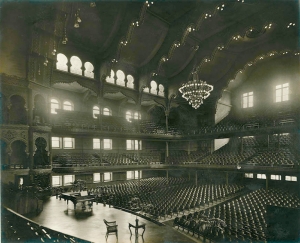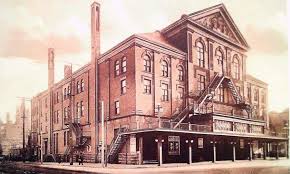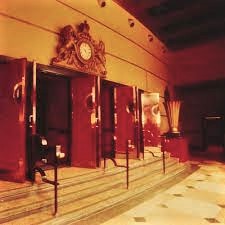Massey Hall: A Century of Renovation

In this early photograph, the chandelier appears afloat in the middle of Massey Hall’s auditorium, seen here flooded with natural light.
Roy Thomson Hall/Massey Hall Performance Magazine – Spring 2005
A photo in the National Archives shows Massey Hall like you’ve never seen her before.
An elegant chandelier appears afloat in the middle of an auditorium flooded with natural light from four levels of stained-glass windows. The brilliantly polished stage floor glistens like a sheet of ice. Intricately etched Moorish arches frame boxes on stage left, with the fourth tier windows – seemingly ablaze – echoing their shape. Archways span the ceiling – decades before a protective wire mesh was grafted on to it in the 1950s – exhibiting a detailed craftsmanship long hidden from view.
For many of us, it seems that the only Massey Hall renovation has been the occasional paint job and the inevitable accumulation of dirt on its façade. Indeed, though I’d visited the Hall hundreds of times over the years, it never quite clicked-in that the Art Deco lobby and balcony lounge could not possibly have sprung from the imagination of architect Sidney Rose Badgley back in 1894. In fact, I only recently realized, while reading William Kilbourn’s evocative history of Massey Hall, Intimate Grandeur, and poring over the book’s historic photos, that the Old Lady of Shuter Street had indeed undergone substantial reconstructive surgery. Twice, in fact. Not to mention the numerous other nips and tucks performed on her throughout the last century.
The “Entombed” Stained Glass Windows
One of the Hall’s most dramatic alterations occurred when the auditorium stained-glass windows were blocked off, victims of the street noise that accompanied the growing popularity of the automobile. Amazingly, most are still in place, and still visible from the street. Only the ground floor panels – a remarkable series of composers’ portraits – are boarded up on both sides. Though likenesses of Bach, Beethoven, Handel and Haydn were removed in 1911, when fire escapes were installed, those of Mozart, Mendelssohn, Rossini, Chopin, Wagner, Gounod, Schubert, and Weber patiently await rescue from their entombment.
Professor Shirley Anne Brown, Director of the Registry of Stained Glass Windows in Canada has noted that the Hall contains “the largest single integrated set of Art Nouveau commercial glass in Ontario and perhaps Canada.” Though the glass needs cleaning, and the metal wiring securing them in place needs repair, most are in fairly good shape.
While the effect of the windows can’t possibly be appreciated in black and white photos, Douglas Gardner, a longtime Roy Thomson Hall/Massey Hall volunteer and chairman of the tour program, did hear the testimony of one eyewitness. At a presentation for the Swansea Historical Board a few years ago, Gardner asked audience members about their first visit to Massey Hall. A woman in her 90s, Gardner says, “lit up like a Christmas tree.” A little girl when she first visited the Hall, she remembered nothing of what took place on stage. But, she says, she vividly recalled the windows, and the magic of “being surrounded by this marvellous light, this gorgeous, soft mixture of coloured light coming from all levels.”
In 2002, the three centre panels on each side of the fourth level were shorn of decades-old coats of paint. Now they are illuminated before concerts and at intermissions – the attic windows, which do not face the street, were originally lit with gas lamps – and we can finally get a glimpse of the Hall’s hidden riches.

A canopy running the full length of Massey Hall was added to the building in 1911 and demolished 31 years later, the victim of a war-time steel shortage.
Along with the fire escape in 1911 came a dramatic addition to the exterior of the Hall – an enormous canopy extending out to the curb and running the full length of the Hall along Shuter Street. It would protect visitors from the elements until 1942, when rusted out steel girders led to its demolition. Had the country not been at war, the canopy probably would have been replaced. As it was, its many tons of steel were slated for the war mills.
By the late 1920s, the Hall was considered by many – including Vincent Massey, Hart’s grandson and the future Governor-General of Canada – to be shabby and outdated. In 1929, with the intention of building a more modern concert hall, the board agreed to sell it for $650,000. When no one stepped forward, discussions began on a major renovation.
A New Lobby: From Victorian to Art Deco
The board apparently solicited advice from various sources. In the summer of 1933, F. C. Schlang of Columbia Concert Corporation in New York wrote to J. Stanley McLean, Massey Hall chairman at the time. Included with his suggestions were some fascinating observations.

Massey Hall’s original lobby was criticized for its small size and dustiness. This is the only existing photo of the Victorian lobby.
“The main fault of Massey Hall,” Schlang wrote, “is that the lobby is too small and if there is any line at all of purchasers of tickets on the evening of a concert, they are compelled to stand in a cold, drafty queue reaching down a flight of stairs . . . [W]ould it not be possible to increase the size of the lobby by sacrificing two or three rows of the back of the orchestra, as these seats are not often taken anyway?”
“If a new lobby is constructed, the material used for flooring should be other than wood, preferably some composition which is easily cleaned with soap and water. The lobby of Massey Hall has always a dusty smell. A similar improvement would be welcome to the treads of the stairways leading to the balcony.”
The most significant changes to the Massey Hall renovation that began that fall were the reconfiguration of the staircases, the addition of a balcony lounge, and the expansion of the lobby. As well, the auditorium was repainted in red and gold and elegant, shaded lamps were installed.
While Massey Hall’s lobby may not be generously proportioned by today’s standards, the original – measuring about 25 feet across by 16 feet deep – was tiny. The walls were brick; the floor, as Schlang said, was wood. A flight of stairs at each side of the lobby area led to box offices that could also be reached from outside entrances at the east and west ends of the Hall off Shuter Street. (You can still make out where the old doors once were by observing the arrangement of brick that today frames the ticket booths.) Visitors climbing to both the balcony and gallery would share a single set of wooden stairs.
The 1933 renovation lowered the lobby to ground level and enlarged it by removing the last two rows of downstairs seats. A ramp leading straight through to the auditorium’s ground floor was built, along with, The Toronto Star wrote, “a battery of hot-air faucets to kill the draughts.”
What had been the back wall of the auditorium became the rear wall of an inner lobby. (If you look closely at the plaster, you can still see the “scars” where the old floor and wall met.) The wooden floor was replaced with marble terrazzo. And the wooden staircases were replaced with two pair of broad, stone stairways that efficiently redirected the flow of traffic. (Here too, amateur sleuths will note the markings in the stairwells’ old plaster walls that reveal the configuration of the original stairs.)

The lobby was renovated in 1933 in the popular Art Deco style of the day.
Also of interest is the clock now hanging above the foyer doors. Originally a fixture of the Parliament of Upper Canada on Front Street, it came to Massey Hall via the Queen’s Hotel, torn down in the late 1920s to make way for the Royal York Hotel.
The removal of the last six rows of balcony seats cleared the way for a much-needed lounge. Like the lobby, it was also Art Deco. (The style was very much in vogue in the early 1930s; three spectacular Deco buildings – the Harris Filtration Plant, Maple Leaf Gardens and Eaton’s College Street store – were built in Toronto at that time.)
The Grand Re0pening . . . Before Further Massy Hall Renovation
Certainly the vast majority of those attending the reopening concert agreed with the Evening Telegram’s Edward W. Wodson when he wrote of the “temptation to forget the music of the evening awhile and tell about architectural revolutions, stately promenades, atria and vestibules and stairways of ingenious arrangement and construction.”
But at least one Telegram colleague regarded the newfound luxuries as unnecessary distractions. “The lounge and the larger foyers are concessions to that restless trend of modern life,” he wrote, “which compels theatre goers to promenade between acts and to smoke. In the old Massey Hall, it was assumed that people went there to relax and listen to the message of music’s glorious voice.”
But 15 years later, workers were once again tearing the place apart. This time, it was the auditorium’s turn to be converted into a construction site. Concerns about fireproofing led to a concrete floor being built beneath the orchestra seats and stage, which was also lowered by a foot to improve sight lines. Cushioned seats replaced the wooden ones downstairs and, the following year, on the first balcony. Not all were pleased about the premature opening of the hall after only the ground floor renovations. “The ground floor is grand,” Margaret Aitken wrote in her Toronto Telegram column, “but above that . . . the dust and shoddiness is appalling. Even the piano was dusty. I am sure every housewife present could hardly restrain herself from going on to the stage there and then, armed with a duster.”
The columns of golden cubes, completely covering most of the boxes, were probably installed at this time, though many of the boxes had been boarded up before 1948. They can still be reached as they always had, from the entrances off the back stairwells. One of them was occupied for years as a CBC broadcast booth. Today, their condition is far from pristine, and most are storage rooms. Surprisingly, from the inside looking out, the original Moorish archways can still be seen.
A number of hidden improvements to the Hall have been undertaken over the past decade or so, including updated electrical systems, various structural repairs, and new fire panels and sprinklers. Washrooms, too, have been added and accessibility has been improved. The roof, given a life expectancy of one hundred years in 1894, was replaced right on schedule.
A more conspicuous renovation took place in 1995, when the basement – the coat-check for visitors to the Hall and a dungeon to the musicians who used it as a storage area – was transformed into the Centuries Lounge.
The Unsolved Mystery
While we’ve pieced together much of Massey Hall’s history by examining photos, documents, news clippings and clues embedded in the building itself, one particular alteration leaves us baffled to this day.
The glass and bronze chandelier that hung from the centre of the auditorium was the most spectacular Toronto had ever seen. Comprised of 400 electric and gas lights, its New York State manufacturer proudly claimed that it was the biggest the state had ever produced. Exactly why or when it was removed is not known. No documentation suggesting where it was taken exists. If it was hauled out in one piece or turned into 400 lamps that made their way into homes throughout the province, we don’t know.
All that we know for sure is that it has disappeared without a trace.



Family lore has it my grandfather Jack Slack (John Henry Rawsthorne Slack) played violin at Massey Hall. The date is unclear but he died in 1911. He could have been part of a military band with the Queen’s Own Rifles.